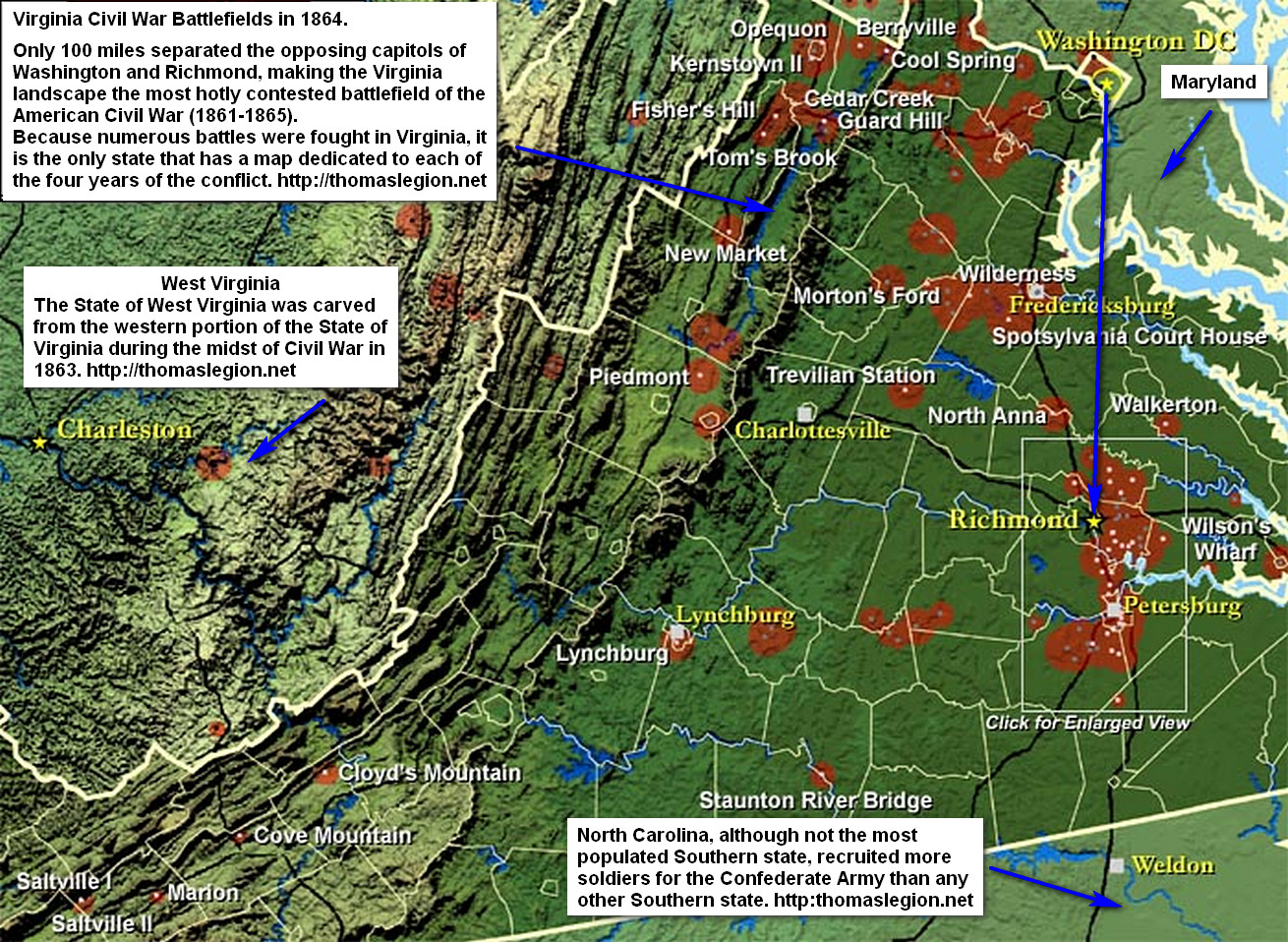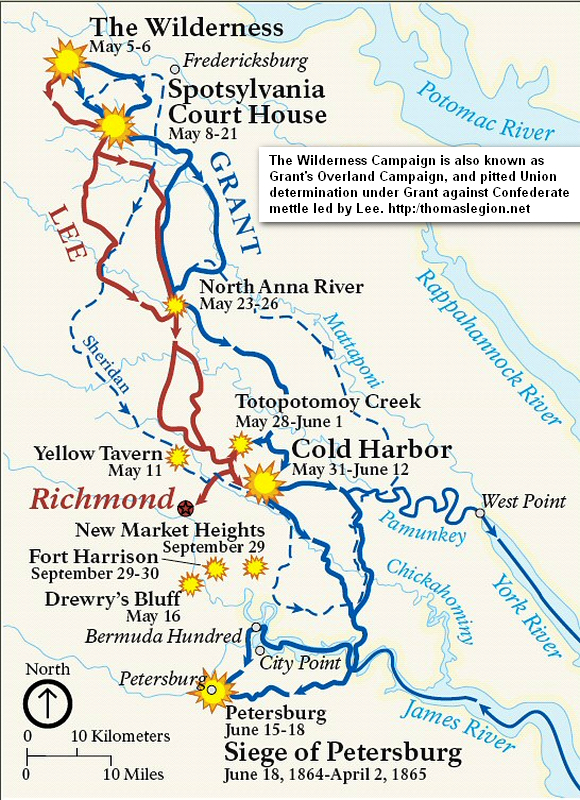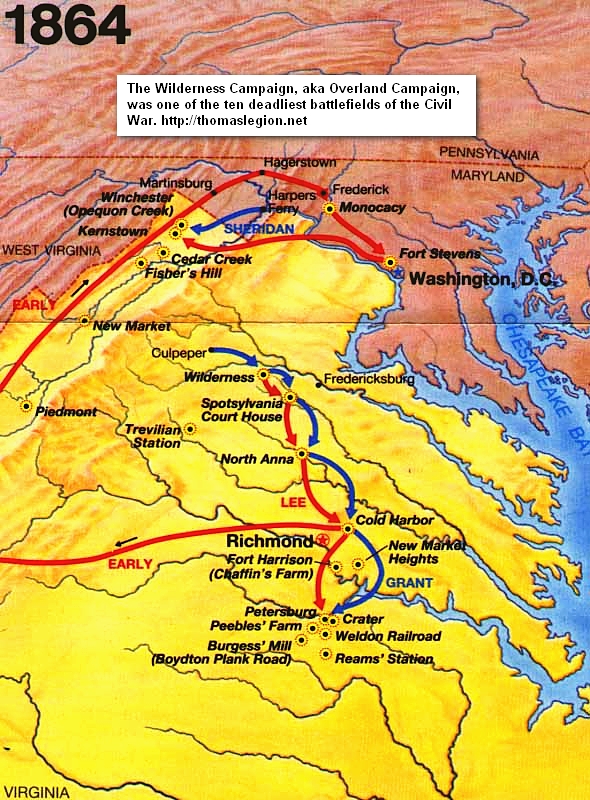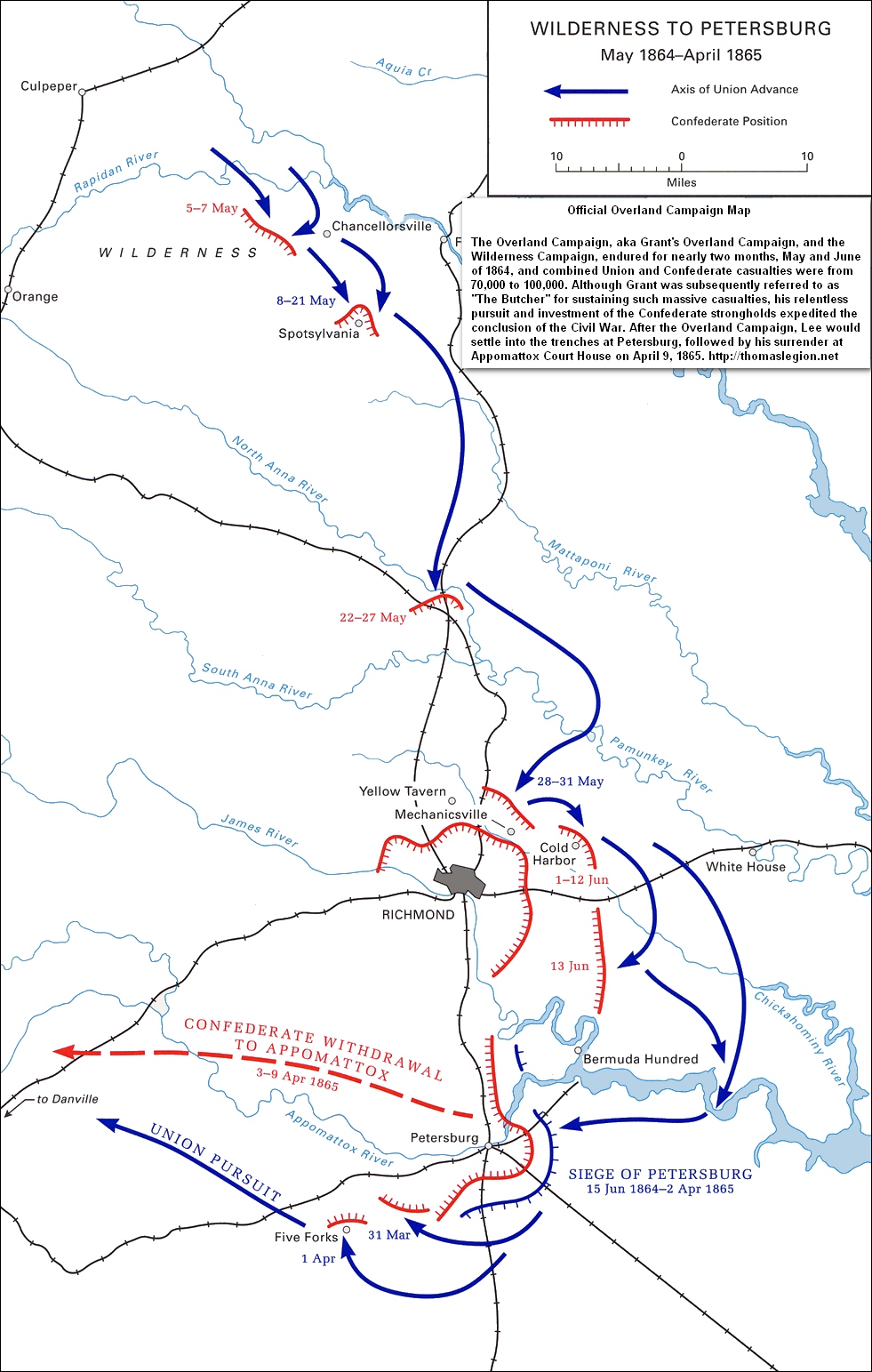
|

|
Introduction
The Overland Campaign, also known
as Grant's Overland Campaign or the Wilderness Campaign, witnessed unprecedented carnage on both sides, with both the Battle
of the Wilderness and the Battle of Spotsylvania Court House listed in the Ten Deadliest Battles of
the American Civil War. In regards to the Overland Campaign's single engagement at Cold Harbor,
Grant stated, "I regret this assault more than any one I ever ordered."
The last full year of campaigning
in the east begins with Federal forces east and west making a unified effort to wear down the South's will to continue fighting.
Lincoln has promoted Ulysses S. Grant to the rank of lieutenant general and placed him in command of all Union armies. His
mission: destroy Joe Johnston's Army of Tennessee and Lee's Army of Northern Virginia.
Leaving Maj. Gen. William T.
Sherman to engage Johnston, Grant concentrates on Lee. Their first encounter, the Battle of the Wilderness, commenced on May 5, 1864, and for the next 40 days the armies remain locked
in deadly embrace. The course of the fighting leads through Spotsylvania Court House, across the North Anna River to Cold Harbor, and finally to Petersburg. There the opponents settle down to a siege, punctuated by Grant's relentless efforts to outflank the Confederates
and seize vital transportation arteries. His attempt to capture Petersburg outright fails at the Battle of the Crater. Meanwhile,
Lt. Gen. Jubal Early's Confederate troops expel Union forces from the Shenandoah Valley and march to the outskirts of Washington, before being turned back at Fort Stevens. Outnumbered but defiant, they return to the Valley where, in a series of hard-fought
engagements, Maj. Gen. Philip Sheridan erases Early's army from the war.
| (Map) Civil War Battles of Virginia in 1864 |

|
| The Overland Campaign is also known as the Wilderness Campaign Map |
(About) Fredericksburg, Chancellorsville, Wilderness, and Spotsylvania--this
is America's battleground, where the Civil War roared to its bloody climax. No place more vividly reflects the War's tragic
cost in all its forms. A town bombarded and looted. Farms large and small ruined. Refugees by the thousands forced into the
countryside. More than 85,000 men wounded; 15,000 killed--most in graves unknown.
Overland Campaign
Grant's Overland Campaign pitted two well-known, seasoned generals against
one another and included two of the top ten deadliest Civil War battles and another battle that Grant regretted. The Overland
Campaign was a series of tactical Union defeats that were concluded with an overall strategic Union victory.
The Overland Campaign, also known
as Grant's Overland Campaign or the Wilderness Campaign, was a series of battles fought in Virginia during May and June 1864, in the
American Civil War. Lt. Gen. Ulysses S. Grant, general-in-chief of all Union armies, directed the actions of the Army of the
Potomac, commanded by Maj. Gen. George G. Meade, and other forces against Confederate Gen. Robert E. Lee's Army of Northern
Virginia. Although Grant suffered severe losses during the campaign, it was a strategic Union victory. It inflicted
proportionately higher losses on Lee's army and maneuvered it into a siege at Richmond and Petersburg, Virginia, in just over
eight weeks. Total casualties for the Overland Campaign are estimated from 70,000 to 100,000.
Crossing
the Rapidan River on May 4, 1864, Grant sought to defeat Lee's army by quickly placing his forces between Lee and Richmond
and inviting an open battle. Lee surprised Grant by attacking the larger Union army aggressively in the Battle of the Wilderness
(May 5–7), resulting in heavy casualties on both sides. Unlike his predecessors in the Eastern Theater, however, Grant
did not withdraw his army following this setback, but instead maneuvered to the southeast, resuming his attempt to interpose
his forces between Lee and Richmond. Lee's army was able to get into position to block this movement. At the Battle of Spotsylvania
Court House (May 8–21), Grant repeatedly attacked segments of the Confederate defensive line, hoping for a breakthrough,
but the only results were again heavy losses for both sides.
Grant maneuvered again,
meeting Lee at the North Anna River (Battle of North Anna, May 23–26). Here, Lee held clever defensive positions that
provided an opportunity to defeat portions of Grant's army, but illness prevented Lee from attacking in time to trap Grant.
The final major battle of the campaign was waged at Cold Harbor (May 31 – June 12), in which Grant gambled that Lee's
army was exhausted and ordered a massive assault against strong defensive positions, resulting in disproportionately heavy
Union casualties. Resorting to maneuver a final time, Grant surprised Lee by stealthily crossing the James River, threatening
to capture the city of Petersburg, the loss of which would doom the Confederate capital. The resulting Siege of Petersburg
(June 1864 – March 1865) led to the eventual surrender of Lee's army in April 1865 and the effective end of the Civil
War.
The campaign included two
long-range raids by Union cavalry under Maj. Gen. Philip Sheridan. In a raid toward Richmond, legendary Confederate cavalry
commander Maj. Gen. J.E.B. Stuart was mortally wounded at the Battle of Yellow Tavern (May 11). In a raid attempting to destroy
the Virginia Central Railroad to the west, Sheridan was thwarted by Maj. Gen. Wade Hampton at the Battle of Trevilian Station
(June 11–12), the largest all-cavalry battle of the war.
| Wilderness Campaign of 1864 Map |

|
| Civil War Wilderness Campaign, aka Grant's Overland Campaign, Map |
| Grant's Overland Campaign Map |

|
| (Map) Wilderness Campaign and Virginia Civil War Battles in 1864 |
Timeline
- March 9:
- Lt. Gen. Ulysses S. Grant assumes command of all armies of the United States
- May 4:
- The Union Army of the Potomac leaves its camps around Culpeper Court House, and
the Confederate Army of Northern Virginia departs from its camps around Orange Court House.
- May 5:
- The Battle of the Wilderness begins with clashes along the Orange Turnpike and Orange
Plank Road.
- May 6:
- After initial Union success along the Orange Plank Road, General Robert E. Lee counterattacks
and drives in both Union flanks, inflicting heavy losses on the Army of the Potomac.
- May 7:
- Grant decides to continue the campaign and issues orders for a night march to Spotsylvania
Court House.
- May 8:
- Grant's march to Spotsylvania is blocked by Lee at Laurel Hill, and both armies
dig in around Spotsylvania Court House.
- May 9:
- Maj. Gen. Philip H. Sheridan starts his Union cavalry raid toward Richmond.
- May 10:
- Grant strives to find a weak point in Lee's line, probing both flanks and attacking
the Confederate front. Only Col. Emory Upton's innovative assault achieves even a partial breakthrough.
- May 11:
- Sheridan defeats the Confederate cavalry at Yellow Tavern and kills the Southern
cavalry leader, Maj. Gen. James E. B. "Jeb" Stuart
- May 12:
- Maj. Gen. Winfield Scott Hancock's Union II Corps scores a breakthrough at the Mule
Shoe salient, but a Confederate counterattack and stand at the Bloody Angle buys time for Lee to construct a new defensive
line.
- May 14:
- Sheridan reaches Haxall's Landing, completing his raid on Richmond.
- May 15:
- Confederate Maj. Gen. John C. Breckinridge turns back Union Maj. Gen. Franz Sigel's
drive up the Shenandoah Valley at New Market, Brig. Gen. George Crook and Brig. Gen. William W. Averell join forces at Union,
West Virginia, after a disappointing week of campaigning against Confederate rail communications and mines in southwest Virginia.
- May 16:
- Confederate General Pierre G. T. Beauregard effectively contains Union Maj. Gen.
Benjamin F. Butler's Army of the James in the earthworks of the Bermuda Hundred Peninsula, ending Butler's threat to Richmond
- May 18:
- After a week of maneuvering, Lee stops cold Grant's assault on the new Confederate
line near the Mule Shoe.
- May 19:
- As Grant prepares to launch a new phase of the campaign, Lee attacks the Union right
flank near Harris Farm, but is repulsed by a force largely consisting of green heavy artillery units from Washington.
- May 23:
- The two armies deploy on both sides of the North Anna River, and the Union V Corps
establishes a bridgehead at Jericho Mills, repulsing a Confederate attack.
- May 24:
- Union forces probe the V-shaped Confederate defensive line along the North Anna
but decide the position is too strong and their own situation too exposed to risk an assault.
- May 25:
- Grant decides to move southeast again toward the Pamunkey River line.
- May 27:
- The Army of the Potomac crosses the Pamunkey River at Hanovertown and Nelson's Crossing.
Lee moves to block the Federal thrust at Totopotomoy Creek.
- May 28:
- Federal cavalry defeats the Confederate horsemen at Haw's Shop, but both sides get
the information they are seeking on enemy dispositions.
- May 30:
- Lee drives in the Union left flank near Bethesda Church but cannot capitalize on
his advantage.
- May 31:
- As Union probes along Totopotomoy Creek find the Confederate position too strong,
Sheridan seizes the crossroads at Old Cold Harbor.
- June 1:
- Grant reinforces Sheridan at Old Cold Harbor with two corps. A Union attack late
in the day gains limited success, and Grant orders another effort for June 2.
- June 2:
- The Army of the Potomac is unable to launch the planned attack, giving Lee time
to move reinforcements to Cold Harbor and to strengthen his works there.
- June 3:
- The Union attack at 0430 at Cold Harbor fails with heavy losses.
- June 12:
- Grant begins his redeployment in preparation to cross the James River.
- June 14-16:
- The Army of the Potomac crosses the James River and begins a new campaign directed
against Petersburg.
| 1864 Overland Campaign Map |

|
| Grant's Overland Campaign Map |
Aftermath
After
Lee learned that Grant had crossed the James, his worst fear was about to be realized—that he would be forced into a
siege of the capital city. Petersburg, a prosperous city of 18,000, was a supply center for Richmond, given its strategic
location just south of the capital, its site on the Appomattox River that provided navigable access to the James River, and
its role as a major crossroads and junction for five railroads. Since Petersburg was the main supply base and rail depot for
the entire region, including Richmond, the taking of Petersburg by Union forces would make it impossible for Lee to continue
defending the Confederate capital. This represented a change of strategy from that of Grant's Overland Campaign, in which
confronting and defeating Lee's army in the open was the primary goal. Now, Grant selected a geographic and political target
and knew that his superior resources could besiege Lee there, pin him down, and either starve him into submission or lure
him out for a decisive battle. Lee at first believed that Grant's main target was Richmond and devoted only minimal troops
under Gen. P.G.T. Beauregard to the defense of Petersburg as the Siege of Petersburg began.
The Overland Campaign was a thrust necessary for the Union to win the war,
and although Grant suffered a number of tactical defeats (most notably Cold Harbor), the campaign was a strategic success
for the Union. By engaging Lee's forces and not permitting them to escape, Grant forced Lee into an untenable position. But
this came at a high cost. The campaign was the bloodiest in American history: approximately 55,000 casualties on the Union
side (of which 7,600 were killed), 32,600 (4,200 killed) on the Confederate. Lee's losses, although lower in absolute numbers,
were higher in percentage (over 50%) than Grant's (about 45%).
*Estimates vary as to the
casualties for the entire campaign. The following table summarizes estimates from a variety of popular sources:
Casualty Estimates for the Overland Campaign
| Source |
Union |
Confederate |
Total
Casualties |
| Killed |
Wounded |
Captured/
Missing |
Total |
Killed |
Wounded |
Captured/
Missing |
Total |
| National Park Service |
|
|
|
38,691 |
|
|
|
31,448 |
70,139 |
| Bonekemper, Victor, Not a Butcher |
7,621 |
38,339 |
8,966 |
54,926 |
4,206 |
18,564 |
9,861 |
32,631 |
87,557 |
| Esposito, West Point Atlas |
|
|
|
55,000 |
|
|
|
20–40,000 |
75–95,000 |
| McPherson, Battle Cry |
|
|
|
65,000 |
|
|
|
35,000 |
100,000 |
| Rhea, In the Footsteps of Grant and Lee |
|
|
|
55,000 |
|
|
|
33,000 |
88,000 |
| Smith, Grant |
|
|
|
almost
65,000 |
|
|
|
35,000 |
almost
100,000 |
| U.S. War Dept., Official Records |
6,586 |
26,047 |
6,626 |
39,259 |
|
|
|
|
|
The massive casualties
sustained in the campaign were damaging to the Northern war effort. The price of gold almost doubled and Abraham Lincoln's
prospects for reelection were put into jeopardy. It was only the later successes at Mobile Bay, the Shenandoah Valley, and
Sherman's capture of Atlanta that turned Northern morale and the political situation around. Grant's reputation also suffered.
The knowledge that he could more easily afford to replace his losses of men and equipment than Lee may have influenced Grant's
strategy. However, historians do not agree that Grant deliberately engaged in numerous attacks merely to defeat Lee solely
through attrition, without regard for the losses to his army, needlessly throwing lives away in fruitless frontal assaults
to bludgeon Lee. The overall strategy of the Overland Campaign depended on using Grant's numerical superiority to allow progressive
shifts to the left by "spare" Union corps while Confederate forces were relatively pinned in their positions by the remaining
Union forces. Such a strategy could not succeed without the continuing threat of defeat by direct assault in each of the positions
assumed by Lee's army. The strategy failed in that Lee, possessing shorter lines of march (being nearer to Richmond, which
was also his base), was able to prevent Grant's forces getting between Lee and Richmond, but was effective in allowing Grant
to draw progressively closer to Richmond up to the battle at Cold Harbor. There, with the barrier of the James River and estuary
to his left, Grant did not have the room necessary to continue such movements. He had to choose one among three possibilities:
attack, shift to the right and thus back toward Washington, or cross the James to get at Lee's supply lines. He attempted
the first, but completed the third, as the second was unacceptable. See also Virginia Civil War History.
Analysis
In the spring of 1863, Lt. Gen. Ulysses S. Grant launched the campaign that
marked the beginning of the end of the American Civil War. During May and June, 1863, he and General Robert E. Lee were locked
in a remorseless struggle that took their armies across the woodlands and farm clearings of central Virginia on the road to
the Southern capital of Richmond.
In the Wilderness, Union and Confederate soldiers battled in an almost trackless
forest in which the opposing sides could hardly see each other and the severely wounded fell victim to spreading flames from
underbrush set afire. At Spotsylvania's Bloody Angle, for over twenty hours, opposing troops grappled from opposite sides
of a breastwork in a pouring rain in some of the fiercest hand-to–hand fighting of the entire war. At Cold Harbor, perhaps
5,000 Federal troops fell in the first hour of a hopeless, bungled attack that Grant would forever regret having ordered.
And at Yellow Tavern, Union horsemen cut down the great Confederate cavalry leader, Maj. Gen. James E. B. "Jeb" Stuart.
The myth of chivalry that Stuart represented could find no room in a grim,
pitiless contest that inflicted almost 100,000 casualties, went far toward ruining two great American armies, and foreshadowed
the massive industrial conflicts of the twentieth century. Yet, after six weeks of bitter, unrelenting combat, the nation
was that much closer to Appomattox Court House and eventual reunion.
Sources: National Park Service; Bonekemper, Edward H., III. A
Victor, Not a Butcher: Ulysses S. Grant's Overlooked Military Genius. Washington, DC: Regnery, 2004. ISBN 0-89526-062-X; Cullen,
Joseph P. "Battle of Spotsylvania." In Battle Chronicles of the Civil War: 1864, edited by James M. McPherson. Connecticut:
Grey Castle Press, 1989. ISBN 1-55905-027-6. First published in 1989 by McMillan; Davis, William C., and the Editors of Time-Life
Books. Death in the Trenches: Grant at Petersburg. Alexandria, VA: Time-Life Books, 1986. ISBN 0-8094-4776-2; Eicher, David
J. The Longest Night: A Military History of the Civil War. New York: Simon & Schuster, 2001. ISBN 0-684-84944-5; Esposito,
Vincent J. West Point Atlas of American Wars. New York: Frederick A. Praeger, 1959. OCLC 5890637; Foote, Shelby. The Civil
War: A Narrative. Vol. 3, Red River to Appomattox. New York: Random House, 1974. ISBN 0-394-74913-8; Furgurson, Ernest B.
Not War but Murder: Cold Harbor 1864. New York: Alfred A. Knopf, 2000. ISBN 0-679-45517-5; Grimsley, Mark. And Keep Moving
On: The Virginia Campaign, May–June 1864. Lincoln: University of Nebraska Press, 2002. ISBN 0-8032-2162-2; Hattaway,
Herman, and Archer Jones. How the North Won: A Military History of the Civil War. Urbana: University of Illinois Press, 1983.
ISBN 0-252-00918-5; Jaynes, Gregory, and the Editors of Time-Life Books. The Killing Ground: Wilderness to Cold Harbor. Alexandria,
VA: Time-Life Books, 1986. ISBN 0-8094-4768-1; Kennedy, Frances H., ed. The Civil War Battlefield Guide. 2nd ed. Boston: Houghton
Mifflin Co., 1998. ISBN 0-395-74012-6; King, Curtis S., William G. Robertson, and Steven E. Clay. Staff Ride Handbook for
the Overland Campaign, Virginia, 4 May to 15 June 1864: A Study on Operational-Level Command. Ft. Belvoir, VA: Defense Technical
Information Center, 2005. OCLC 640114524; Longacre, Edward G. Lee's Cavalrymen: A History of the Mounted Forces of the Army
of Northern Virginia. Mechanicsburg, PA: Stackpole Books, 2002. ISBN 0-8117-0898-5; Longacre, Edward G. Lincoln's Cavalrymen:
A History of the Mounted Forces of the Army of the Potomac. Mechanicsburg, PA: Stackpole Books, 2000. ISBN 0-8117-1049-1;
McPherson, James M. Battle Cry of Freedom: The Civil War Era. Oxford History of the United States. New York: Oxford University
Press, 1988. ISBN 0-19-503863-0; Rhea, Gordon C. The Battle of Cold Harbor. Fort Washington, PA: U.S. National Park Service
and Eastern National, 2001. ISBN 1-888213-70-1; Rhea, Gordon C. Cold Harbor: Grant and Lee, May 26 – June 3, 1864. Baton
Rouge: Louisiana State University Press, 2002. ISBN 0-8071-2803-1; Rhea, Gordon C. The Battle of the Wilderness May 5–6,
1864. Baton Rouge: Louisiana State University Press, 1994. ISBN 0-8071-1873-7; Rhea, Gordon C. The Battles for Spotsylvania
Court House and the Road to Yellow Tavern May 7–12, 1864. Baton Rouge: Louisiana State University Press, 1997. ISBN
0-8071-2136-3; Rhea, Gordon C. In the Footsteps of Grant and Lee: The Wilderness Through Cold Harbor. Baton Rouge: Louisiana
State University Press, 2007. ISBN 978-0-8071-3269-2; Rhea, Gordon C. To the North Anna River: Grant and Lee, May 13–25,
1864. Baton Rouge: Louisiana State University Press, 2000. ISBN 0-8071-2535-0; Salmon, John S. The Official Virginia Civil
War Battlefield Guide. Mechanicsburg, PA: Stackpole Books, 2001. ISBN 0-8117-2868-4; Simpson, Brooks D. Ulysses S. Grant:
Triumph over Adversity, 1822–1865. New York: Houghton Mifflin, 2000. ISBN 0-395-65994-9; Smith, Jean Edward. Grant.
New York: Simon & Schuster, 2001. ISBN 0-684-84927-5; Starr, Stephen Z. The Union Cavalry in the Civil War. Vol. 2, The
War in the East from Gettysburg to Appomattox 1863–1865. Baton Rouge: Louisiana State University Press, 1981. ISBN 978-0-8071-3292-0;
Trudeau, Noah Andre. Bloody Roads South: The Wilderness to Cold Harbor, May–June 1864. Boston: Little, Brown & Co.,
1989. ISBN 978-0-316-85326-2; U.S. War Department. The War of the Rebellion: a Compilation of the Official Records of the
Union and Confederate Armies. Washington, DC: U.S. Government Printing Office, 1880–1901; Welcher, Frank J. The Union
Army, 1861–1865 Organization and Operations. Vol. 1, The Eastern Theater. Bloomington: Indiana University Press, 1989.
ISBN 0-253-36453-1; Wittenberg, Eric J. Glory Enough For All: Sheridan's Second Raid and the Battle of Trevilian Station.
Washington, DC: Brassey's, Inc., 2001. ISBN 1-57488-468-9.
Return to American Civil War Homepage

|

|

|

